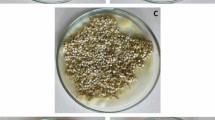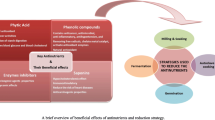Abstract
Japanese mint (Mentha arvensis) oil (JMO) can be used effectively as fumigant againstSitophilus oryzae in stored sorghum. The effect of JMO at a dose of 166 µl/l of space on nutrient composition and protein quality was studied in infested and uninfested sorghum grains stored for 3 months. The results revealed non significant effect of JMO on gran moisture, total ash, crude fibre, crude fat, crude protein and fat acidity in infested and uninfested grains at the end of 3 months storage. The JMO treatment had small but significant effect on reducing and nonreducing sugars. The values of Protein Efficiency Ratio (PER) for uninfested JMO treated grains, infested JMO treated grains and for untreated control stored for 3 months were 1.11, 1.07 and 1.09, respectively against control casein diet for which it was 2.15.
Similar content being viewed by others
References
Pant KC, Susheela TP (1977) Effect of storage and insect infestation on the chemical composition and nutritive value of grain sorghum. J Sci Food Agric 28: 363–370.
Khare BP (1972) Insect pests of stored grain and their control in Uttar Pradesh. GB Pant University of Agriculture and Technology, Pantnagar, Nainital (UP) India, pp. 109–120.
Srivastava S, Gupta KC, Agrawal A (1989) Japanese mint oil as fumigant and its effect on insect infestation, nutritive value and germinability of pigeonpea seeds during storage. Seed Res 17 (1): 96–98.
Singh M (1993) Use of Japanese mint oil in stored sorghum and its effect on grain quality. MSc Thesis. Department of Foods and Nutrition, GB Pant University of Agriculture and Technology, Pantnagar, Nainital, India.
AACC (1962) Approved Methods of American Association of Cereal Chemists, 8th ed. St Paul, MN.
AOAC (1965) Official Methods of Analysis. Washington, DC: Association of Official Analytical Chemists.
Campbell JA (1963) Evaluation of Protein Quality. Washington, DC: National Academy of Sciences — National Research Council, Publication 1100.
ISI (1974) Method for determination of protein efficiency ratio, Indian Standard, IS: 7481. New Delhi: Indian Standard Institute.
Snedecor GW, Cochran WG (1967) Statistical methods. Calcutta: Oxford IBH.
Ratna D (1992) Changes in sorghum grain quality during storage. MSc Thesis. Department of Foods and Nutrition, GB Pant University of Agriculture and Technology, Pantnagar, UP, India.
Nikholoyev AG, Lezuinkhan (1986) Essential oils ofMentha arvensis of the Vietnam flora. Rastil Requr 22: 96–99.
Pomeranz Y (1974) Biochemical, functional and nutritive changes during storage. In: Christensen CM (ed), Storage of cereal grains and their products. St Paul, MN: AACC, pp. 56–114.
Axtell JD, Ejeta G, Munck L (1982) Sorghum nutritional quality — progress and prospects. In: Sorghum in the Eighties, Proceedings of the International Symposium on Sorghum, Vol. 2. Patancheru, India, pp. 589–603.
Author information
Authors and Affiliations
Rights and permissions
About this article
Cite this article
Singh, M., Srivastava, S., Srivastava, R.P. et al. Effect of Japanese mint (Mentha arvensis) oil as fumigant on nutritional quality of stored sorghum. Plant Food Hum Nutr 47, 109–114 (1995). https://doi.org/10.1007/BF01089259
Received:
Accepted:
Issue Date:
DOI: https://doi.org/10.1007/BF01089259




